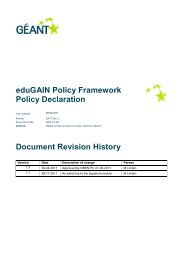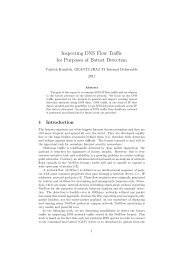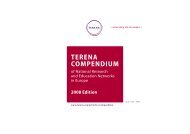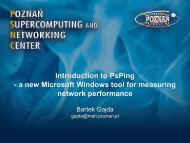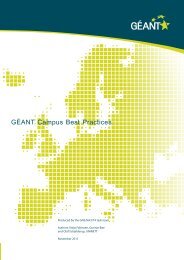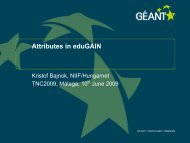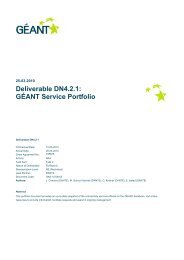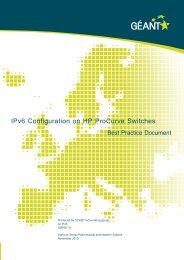Guide to configuring eduroam using a Cisco wireless controller Best ...
Guide to configuring eduroam using a Cisco wireless controller Best ...
Guide to configuring eduroam using a Cisco wireless controller Best ...
You also want an ePaper? Increase the reach of your titles
YUMPU automatically turns print PDFs into web optimized ePapers that Google loves.
authentication can be completed. Here one can choose between <strong>using</strong> self-generated or purchased<br />
certificates.<br />
Self-generated certificates is the most secure option, but entail significant extra work, since it is<br />
necessary <strong>to</strong> perform a separate certificate installation in every single client which is <strong>to</strong> be granted<br />
access <strong>to</strong> the <strong>wireless</strong> network. The way in which you save your own root certificate and your own<br />
certificate hierarchy is described in Chapter 4 of UFS112 [1].<br />
A simpler and “secure enough” way <strong>to</strong> achieve this is <strong>to</strong> make use of UNINETT’s server certificate<br />
service, SCS (http://www.uninett.no/scs). UNINETT is actually a member of TERENA’s TCS (TERENA<br />
Certificate Service) project and can supply user certificates <strong>to</strong> our members who belong <strong>to</strong> Comodo<br />
UserTrust. Most operating systems are accompanied by a client certificate with a public key from<br />
Comodo UserTrust. A detailed “cookbook” for ordering a UNINETT SCS certificate is available at<br />
http://forskningsnett.uninett.no/scs/hvordan.html. When you have received a certificate it must be<br />
installed in your RADIUS server. See Attachment C for installation of a certificate for FreeRADIUS 2.x.<br />
Once IEEE 802.1X is functioning internally, the national connection <strong>to</strong> <strong>eduroam</strong> can be configured. In<br />
general terms this involves rerouting the requests from users with unrecognised realms and accepting<br />
requests from one’s own users who are visiting other institutions. For more information about <strong>eduroam</strong>,<br />
see Chapter 10 of UFS112 [1] and the “<strong>eduroam</strong> cookbook” [2].<br />
- Obtain server certificate for RADIUS<br />
- Configure RADIUS server for the user database<br />
- Connect RADIUS server <strong>to</strong> <strong>eduroam</strong> (<strong>to</strong>p level in Norway is handled by<br />
hegre.uninett.no and trane.uninett.no)<br />
- Filter:<br />
o RADIUS Authentication UDP 1812 <strong>to</strong>/from hegre.uninett.no and<br />
trane.uninett.no<br />
o RADIUS Accounting UDP 1813 <strong>to</strong>/from hegre.uninett.no and<br />
trane.uninett.no<br />
o RADIUS Proxy UDP 1814 <strong>to</strong>/from hegre.uninett.no and<br />
trane.uninett.no<br />
13



